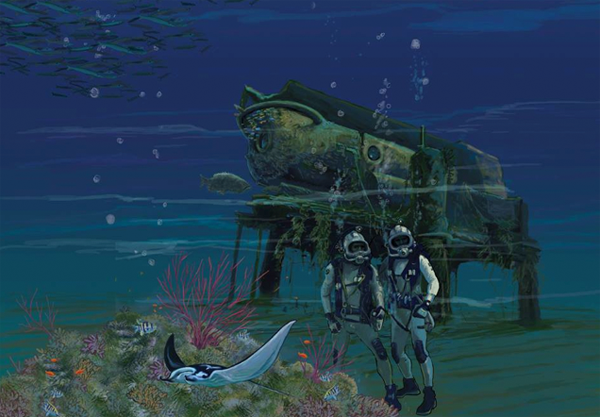Fabien Cousteau, world-renowned ocean advocate, filmmaker and grandson of pioneering ocean explorer Jacques-Yves Cousteau, accomplished just that last month during Mission 31, his record-breaking quest to spend 31 days beneath the sea in the world’s only underwater research laboratory!
Deeper, Longer, Further
From June 1 to July 1, 2014, Fabien carried on the Cousteau legacy of ocean exploration as he commemorated the 50th anniversary of his grandfather’s 30-day underwater mission, Cousteau Conshelf II, by living underwater one full day longer and twice as deep. By following in his grandfather’s footsteps, Fabien hopes to deepen the human-ocean connection around the world.
For the duration of Mission 31, Fabien and his team of “aquanauts” lived in the Aquarius Reef Base, the world’s only undersea research laboratory, 60 feet below the surface of Florida Keys National Marine Sanctuary. They set out not only to break records, but also to conduct cutting-edge research on the dynamics of a coral reef ecosystem over an entire lunar cycle.
Inside Aquarius
Nine miles from shore and 63 feet below the ocean’s surface, Aquarius is a fully submerged marine habitat for humans. It sits on a small patch of sand at the edge of a reef, surrounded by colorful fish, bright corals, and the occasional goliath grouper. With its bright yellow color, the structure has been likened to The Beatles’ Yellow Submarine or Ms. Frizzle’s Magic School Bus, and it serves a similar purpose: to allow humans to live and explore the underwater world.
Aquarius was deployed in 1993 and has since hosted more than 120 missions and produced research used in more than 600 scientific papers. Owned and operated by Florida International University, Aquarius contains all (well, most of) the comforts of home: six bunk beds, hot water, a small kitchen, and air conditioning. Aquarius even has Wi-Fi so you can watch the Aquanauts in action via live webcams, Google hangouts, Skype calls, and social media updates offering a glimpse into their lives beneath the waves. Thanks to this modern technology, people all over the world are able to participate in this adventure and discover more about our magnificent ocean planet.
Pushing the Limits with Saturation Diving
Fabien was able to spend an entire month underwater thanks to a technique called "saturation diving." Normally, scuba divers can only spend a limited amount of time underwater because the pressure causes gases to dissolve into their blood and tissues. In order to return to the surface safely, a diver must ascend slowly to allow those gases to safely leave their body — surface too quickly, and tiny bubbles can form internally, like the carbonation of a can of soda. Known as decompression sickness, or "the bends," this can have potentially deadly consequences.
But decompression sickness isn't a concern if the diver doesn't have to surface. Saturation divers adjust to the pressurized environment of Aquarius and reach a point where no more gas can dissolve into their blood, meaning they only have to decompress once at the end of the mission. As long as the Aquanauts return to Aquarius after each dive, they can dive up to nine hours per day without suffering any ill effects!
An Underwater Amazon: A Glimpse into the Florida Keys National Marine Sanctuary
Located at the southeastern tip of the Florida peninsula, Florida Keys National Marine Sanctuary is a treasure trove of marine life. In addition to being the home of the Aquarius Reef Base, the sanctuary contains the world’s third-largest barrier reef and more than 6,000 species of marine life. There is still much to learn about the complex system that drives life on a coral reef and through Mission 31, the Aquanauts worked to shed some light on this fragile and critical ecosystem.
Fabien and his team spent their month underwater investigating some essential questions about the ocean, looking for lasting effects of the BP oil spill and how ocean acidification is affecting coral reefs. They also took a closer look at some important marine species, such as ancient sponges that can live for hundreds of years, and the life history of plankton — some of the ocean’s tiniest but most important inhabitants — over an entire lunar cycle. The research the team completed will provide valuable insights into the inner workings of coral reefs, helping us better understand how to protect these precious resources for the future.



